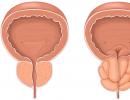Diet Kovalkov: menu by stages
The author of the weight loss method, Alexey Kovalkov, knows from himself what excess weight means and how an obese person feels. Alexey has a medical degree, but his own health problems pushed him to become a nutritionist. According to the doctor, he gained excess kilograms while studying at the medical institute and weighed more than 150 kilograms. At some point, Alexei realized that further weight gain is the way to the cemetery, and it's time to start working on yourself.
Once Kovalkov was invited to the United States, where, in contrast to Russia, scientific dietetics was developed. In America, Alexey learned a lot for himself, gaining access to relevant literature, experiences and developments of Western specialists. The nutritionist was able to lose weight himself - he lost 52 kg. Dr. Kovalkov has opened a weight correction clinic in Moscow, blogs, and also attends nutrition-related television programs as an expert.
Weight loss rules and principles
Following the Kovalkov diet, almost everyone can lose weight. The author of the technique formulated several main theses that formed its basis:
- Before starting the Kovalkov diet, you need to psychologically tune in to a positive mood. It is worth remembering that you can lose weight without torturing the body.
- Daily adherence to a well-formulated diet.
- Eat fractionally at least 5 times a day. For short periods of time between meals, the body does not have time to get very hungry and will not accumulate excess weight.
- Take vitamins and drink water between meals.
- Reduce the consumption of animal fats (butter, lard, fatty meat) and animal protein.
- Long walks - from 15 minutes to an hour, depending on the pace. Light physical activity helps to saturate the body with oxygen and normalize metabolism.
- Limit salt intake - Sodium chloride makes you thirsty, contributing to swelling.
Features of the drinking regime
According to Kovalkov's observations, it is necessary to drink, but it is impossible to do it through force. Someone needs to drink 2.5 liters of liquid per day, but 1.5 is enough for someone. The main thing is not to forget to drink between meals (half an hour before meals). It can be tea, coffee, compote, juice, plain water. An indispensable condition is not to drink food with water, otherwise the digestion process is disrupted, which is fraught with excess fat settling on the hips and waist.
Meals according to Kovalkov
- find out the reason for excess weight - everyone may have their own;
- start to control your diet, striving for a healthier diet;
- set a goal - and move towards it slowly but surely.
It is not difficult to build your diet according to the rules of the Kovalkov diet - many types of foods are allowed. It is important to pay attention to the method of preparation - to exclude fried foods, replacing them with steamed, boiled or baked. The second condition is fractional meals in small portions so as not to overeat. Guided by these principles, you can build a menu for the day, for the week and for the month.
List of approved products
The Kovalkov diet is planned on the basis of products permitted for consumption. Among them are the following:
- cereals, except semolina, rice;
- vegetables;
- legumes: peas, beans, chickpeas, lentils;
- fruits other than bananas;
- greenery;
- fermented milk products with low fat content, milk;
- eggs;
- from the second stage - lean meat, fish, any seafood;
- nuts;
- mushrooms.
Prohibited foods
It is important to control that foods with a high glycemic index, fatty meats, and starchy vegetables are not included in the diet. The Kovalkov diet implies a strict restriction in the preparatory and first stages, after which some dishes are allowed to eat. The ban applies to the following products:
- flour and confectionery products, desserts;
- potatoes, beets, carrots;
- fast food: hot dogs, hamburgers, snacks;
- fatty meat, lard, butter;
- sweet sparkling water;
- sauces: mayonnaise, ketchup;
- white rice, potatoes, pasta;
- dried fruits, bananas, pears, grapes;
- alcohol.
Diet stages
The author of the technique proposes to divide the nutritional system into three stages - preparatory, main and to consolidate the result. Dr. Kovalkov's diet involves strict adherence to the rules for building a diet and feasible physical activity, which grows as the kilogram is lost. It is important to rebuild on time, change the diet, not forgetting to control your weight.
Stage I - preparatory
Changing the diet and lifestyle in general should be gradual so that the body does not experience stress. The first stage of the diet lasts 2-3 weeks and during this period it is necessary to cleanse the gastrointestinal tract from toxins, normalize the intestinal microflora, this will lead to the restoration of metabolism. To lose 5-6 kg, you should follow the rules:
- eat 5 times a day;
- give up "fast" carbohydrates: flour dishes, desserts, sweet soda, fast food;
- consume fermented milk products, fresh vegetables, fruits, egg whites (2 pcs per day);
- add fiber to the diet (100 g of bran per day);
- drink clean water at will;
- organize walks every day - 15 minutes at a fast pace or 1 hour at a slow pace.
Stage II - main
After the first phase, it is worth consolidating the result obtained, for this there is a second stage of the Kovalkov diet. The main period lasts as long as is required for weight loss. The diet remains the same - 5 meals a day, the last meal is up to 6 pm In the diet, in addition to the already familiar foods, include lean meat (veal, chicken fillet, turkey), fish, eggs. The amount of proteins per day - 100 g, bran - 100 g.
Physical activity is becoming different - the main emphasis is on strength training. In the main phase of the diet, fat is burned, but it is necessary to build up the muscle mass lost in the first stage. Aerobic exercise (walking or running) supplement with squats, exercises with dumbbells, swimming, jumping rope. Weight will go away more slowly - 200 g per day.
Stage III - fixing
You should proceed to this phase after reaching the optimal weight. The Kovalkov diet at the final stage can last from a year, but it is not difficult to adhere to nutritional rules for a long time, because the diet becomes richer. It is allowed to add bran bread, potatoes (baked or boiled) and red wine to the menu. In the morning, you can use butter.

Alexey Kovalkov's diet - menu
In order to compose a diet according to the rules of the diet, you should use the permitted foods listed above, or you can use a ready-made meal plan. Every day there should be at least 5 meals, the last of which no later than 6 pm. It is worth remembering that the difference in the menu between the stages is significant, because the Kovalkov system in the first phase is strict, in the second and third it is easier to tolerate.
For the first week
The diet for the initial phase is relatively poor, but it can be varied. The first week is challenging, as it marks the transition from regular to dietary meals:
| Day of week | |||||
| Monday | Cottage cheese (50 g), grapefruit. | Fruit dessert: kiwi, pineapple, apple, grapefruit (200 grams). | Vegetable puree soup: broccoli, onion, asparagus, celery (150 grams). | Proteins of 2 eggs. | Baked apples (2 pcs.). |
| Yogurt with bran (0.2 kg). | Cottage cheese (50 grams). | Baked leeks, cauliflower, vegetable marrow filled with 2 proteins, sour cream (150 grams). | Vegetable salad of cabbage and tomatoes with olive oil (150 grams). | Stewed zucchini, onion, tomato, chopped in a blender (150 grams). |
|
| Proteins of 2 eggs. | Stew of zucchini, cabbage, tomatoes, onions, peppers (150 grams). | Tomato, pepper, celery salad (200 grams). | Cottage cheese (50 g), grapefruit (1 pc.). |
||
| Milk oatmeal (150 g), bran (1 tbsp. L.). | Apricots (200 grams). | Salad: cabbage, bell peppers, tomatoes, cucumbers, 2 squirrels (200 grams). | A handful of nuts, yogurt (150 grams). | Stew of broccoli, zucchini, leeks, tomato (150 grams). |
|
| Muesli on water (150 grams). | Two apples. | Thick vegetable soup: asparagus beans, onions, zucchini, celery (200 grams). | Sweet peppers, onions, tomatoes, cucumbers, herbs (200 grams). | Proteins of 2 eggs. |
|
| Proteins of 2 eggs. | Grapefruit. | Steamed asparagus, cauliflower, celery (200 grams). | A handful of nuts. | 2 baked apples. |
|
| Sunday | Cottage cheese with fruit (70 grams). | Plums (100 grams). | Cabbage with herbs and tomatoes with boiled protein (200 grams). | Zucchini caviar (150 grams). | Boiled protein, kefir (150 grams). |
For a month
After the end of the first phase, which can last no more than three weeks, the diet changes slightly. According to the rules of the diet, you can add animal protein and yolks to the menu... Approximate diet for a month:
| Day of month | Lunch | ||||
| Walnuts (4 pcs.) | Apricots, berries (150 g). | Puree soup with chicken breast, onions, broccoli (200 g). | 2 boiled eggs. | Boiled frozen vegetables (150 g). |
|
| Cottage cheese (70 g). | Egg salad (150 g). | Steam veal cutlets (150 g). | Vegetable casserole (150 g). | Kefir with bran (0.2 l). |
|
| Two boiled eggs. | Yogurt with bran (0.2 l). | Turkey meatballs (150 g). | Stewed mushrooms with broccoli (150 g). | Curd cabbage rolls (150 g). |
|
| Two apples. | A handful of nuts. | Soup with meatballs, celery (200 g). | Two boiled eggs. | Zucchini, tomato and garlic casserole (150 g). |
|
| Cottage cheese casserole with apples (100 g). | Vegetable salad (150 g). | Baked fish with lemon (200 g). | Zucchini caviar (100 g). | Yogurt (0.2 l) with a handful of nuts. |
|
| Two boiled eggs. | Grapefruit (1 pc.). | Baked turkey fillet with spinach (200 g). | Tomatoes and cucumbers with herbs (150 g). | Curd cabbage rolls (150 g). |
|
| Kefir with bran (0.2 l). | Stewed mushrooms with herbs (150 g). | Steamed chicken fillet (100 g), vegetable salad (150 g). | Curd casserole with berries (100 g). | ||
| Fruit (150 g). | Two boiled eggs. | Stewed veal zucchini, onion, celery, herbs (200 g). | Cottage cheese and fruits (150 g). | Yogurt (200 ml). |
|
| Cottage cheese, bran (70 g). | Grapefruit (1 pc.). | Thick soup with chicken fillet, celery (200 ml). | Mushroom caviar (150 g). | Baked apples (2 pcs.). |
|
| Oatmeal in water (100 g), grapefruit. | Yogurt with bran (150 g). | Steamed veal cutlets (100 g), cabbage salad (150 g). | Steam omelet with 2 eggs. | Cottage cheese casserole with pineapple (100 g). |
|
| Curd casserole (100 g). | Apple (1 pc.) | Soup with meatballs, celery (0.2 l). | Fish meatballs with zucchini (150 g). | Baked vegetables (150 g). |
|
| Two boiled eggs. | Baked turkey fillet (150 g). | Frozen vegetable salad (150 g). | Curd cabbage rolls (100 g). |
||
| Cottage cheese with pieces of fruit (100 g). | Yogurt with a handful of nuts (150 ml). | Baked fish with lemon (150 g). | Mushrooms stewed with onions and bell peppers (150 g). | Baked apples (2 pcs.). |
|
| Oatmeal in water, berries (200 g). | Cottage cheese (70 g). | Turkey meatballs, sweet pepper salad, tomatoes (150 g). | Zucchini caviar (150 g). | Two boiled eggs. |
|
| Cottage cheese casserole with fruit (100 g). | Grapefruit. | Thick soup with chicken fillet and celery. | Baked apples (2 pcs.). | Mushroom caviar (150 g). |
|
| Mushroom caviar (150 g). | Curd cabbage rolls (100 g). |
||||
| Oatmeal in water (150 ml), grapefruit. | Cottage cheese (70 g). | Baked fish with lemon, cabbage and tomato salad (150 g). | Eggplant casserole with tomatoes (150 g). | A glass of kefir. |
|
| Cottage cheese with pineapple pieces (100 g). | Turkey meatballs (150 g), bell peppers, tomatoes (100 g). | Stew of broccoli, celery, leeks (150 g). | Frozen vegetable salad (150 g). |
||
| Yogurt and bran (200 ml). | Puree soup with chicken breast, onion, broccoli and celery (200 ml). | Mushrooms stewed with onions and cauliflower (150 g). | Zucchini caviar (150 g). |
||
| Grapefruit. | Cottage cheese with fruits and bran (70 g). | Baked apples (2 pcs.). | Yogurt with berries (200 ml). |
||
| Oatmeal in water (150 ml), apple. | Vegetable salad with grated cheese (200 g). | Thick soup with chicken fillet and mushrooms (200 ml). | Zucchini caviar (150 g). | Curd cabbage rolls (100 g). |
|
| Kefir (150 ml), a handful of nuts. | Curd casserole (100 g). | Mushroom soup (0.2 l). | Fish meatballs (150 g). | Zucchini caviar (150 g). |
|
| A glass of milk, an egg. | Grapefruit. | Chicken fillet baked with lemon (150 g). | Frozen vegetable salad (150 g). | A glass of kefir. |
|
| Fruit salad dressed with yogurt (150 g). | Curd casserole (100 g). | Puree soup with chicken breast, onion, broccoli (200 g). | Zucchini caviar (150 g). | Boiled egg. |
|
| Oatmeal (150 ml), berries (50 g). | Boiled egg. | Fish baked with tomatoes (150 g). | Stew of leeks, broccoli, tomato, zucchini (150 g). | Yogurt with berries (200 ml). |
|
| Yogurt (150 ml), a handful of nuts. | Grapefruit | Soup with meatballs, celery, cauliflower (0.2 l). | Cabbage, sweet pepper and tomato salad (200 g). | Curd cabbage rolls (100 g). |
|
| Cottage cheese with fruit (100 g). | Yogurt with bran (150 ml). | Chicken fillet baked with mushrooms (150 g). | Zucchini caviar (150 g). | Frozen vegetable salad (150 g). |
|
| Fruit (70 g) with yogurt (150 ml). | Baked apples (2 pcs.). | Thick soup with chicken fillet and vegetables (0.2 l). | Curd casserole (100 g). | Baked vegetables (150 g). |
|
| Oatmeal (150 g), kiwi (1 pc.). | Apple or grapefruit. | Fish baked with tomatoes and mushrooms (150 g). | Frozen vegetable salad (150 g). | Baked apples (2 pcs.). |
|
| Yogurt (150 ml), bran (1 tablespoon). | Berries and nuts (100 g). | Turkey meatballs, sweet pepper salad with tomato (150 g). | Baked pumpkin (100 g). | Curd cabbage rolls (100 g). |
Slimming recipes
Guided by the principles of the Kovalkov diet, you can easily create a diet for weight loss. In order for the menu to be varied, you can use ready-made recipes. Salt should be used in limited quantities, and vegetables and meat should be boiled or steamed... In the second phase of the diet, you can use a grill pan for a brighter flavor.
Frozen vegetable salad
A bright and healthy dish that will help to compensate for the lack of vitamins and minerals in the winter. You can buy frozen vegetables in the form of an assortment, or you can separately by combining Brussels sprouts, asparagus beans, peas, celery. Depending on the stage of the diet, you can add sunflower oil, yogurt, or low-fat sour cream to vegetables.
Ingredients:
- vegetable mixture - 0.5 kg;
- apple - 1 pc.;
- mustard - 1 tsp;
- cucumber - 1 pc.;
- spices to taste.
Way cooking:
- Pour the vegetable mixture into salted boiling water, boil for 5 minutes, drain.
- Cut the cucumber, onion and peeled apple into cubes.
- Mix everything, season with mustard, unsweetened yogurt, add spices.

Vegetable salad with eggs
A simple salad becomes nutritious and tastes more delicate by adding eggs to the ingredients. During the first phase of the diet, you can use proteins, and in the second phase, a whole egg. It is advisable to cook the dish immediately before serving, so that the vegetables do not have time to let the juice out. You can change the taste of the salad with a dressing - use yogurt or vegetable oil.
Ingredients:
- bell peppers - 2 pcs.;
- tomato - 2 pcs.;
- green onions - 4-5 sprouts;
- cucumber - 2 pcs.;
- boiled egg - 1 pc .;
- greens (arugula, parsley, dill) - to taste;
- spices, salt, balsamic vinegar - to taste.
Cooking method:
- Cut the egg into cubes.
- Chop vegetables, herbs arbitrarily.
- In a large bowl, combine with balsamic vinegar, mustard and salt.
Steamed poultry fillet
Chicken breasts are often dry and not appetizing. In this recipe, poultry fillets come out tender and juicy, while remaining dietary. To prepare it, you can use a steamer, multicooker ("Steam" function) or use the grate, which is installed in the pan. The taste of the finished dish will not change from the choice of the device.
Ingredients:
- chicken breast - 2 pcs.;
- soy sauce - 4 tablespoons l .;
- lemon juice - 20 ml;
- a mixture of peppers;
- salt to taste;
- greens to taste;
- garlic - 2 cloves.
Cooking method:
- Cut the chicken fillet lengthwise into 2 parts.
- Fold in a bowl, pour over soy sauce, lemon juice, sprinkle with pepper.
- Chop the garlic and herbs, add to the fillet, mix. Leave to marinate for an hour.
- Place the fillets on the wire rack and steam for 40 minutes.
Curd cabbage rolls
This hearty dish, which is high in protein, can be prepared at any stage of the diet - preparatory, main and final. The difference lies in the use of egg yolk, which can be omitted from stuffed cabbage rolls if the process of losing weight is in the first stage. In this case, only proteins are used. It is advisable to choose low-fat cottage cheese for stuffed cabbage.
Ingredients:
- Chinese cabbage - 10 leaves;
- cottage cheese - 0.5 kg;
- chicken eggs - 2 pcs.;
- yogurt - 100 ml;
- Salt, spices to taste.
Way cooking:
- Scald cabbage leaves with boiling water.
- In a cup, mix cottage cheese with eggs, salt, you can add nutmeg, black pepper.
- Roll up 10 cabbage rolls, fold into a baking dish.
- Pour over the sauce - mix yoghurt with salt and pepper.
- Bake for 40 minutes at 180 ° C.
Baked vegetables
Baking is an effective way to preserve the maximum amount of nutrients in a dish and make it appetizing. Baked vegetables can help you get through a tough time of restriction and make your diet more varied. Serve the dish as a side dish for meat or fish, you can eat it without companions. Seasonal vegetables will become more aromatic if you use aromatic herbs - thyme, basil.
Ingredients:
- bell peppers - 2 pcs.;
- tomatoes - 2 pcs.;
- leeks - 100 g;
- young zucchini - 1 pc .;
- salt to taste;
- vegetable oil - 1 tbsp. l .;
- greens to taste.
Way cooking:
- Prepare vegetables: peel the seeds from the peppers, peel the tomatoes.
- Cut the ingredients into half rings and slices.
- Fold everything into a mold, season with salt, sprinkle with chopped herbs, pour over with oil.
- Cover with foil and bake at 180 ° C for about an hour.
Advantages and disadvantages of Dr. Kovalkov's weight loss method
A nutritional regimen designed by a dietitian is an affordable way to lose weight. Its advantages:
- A well-designed diet will help you lose weight, increase immunity, and feel healthier.
- A prerequisite is walking, which is good for the lungs and maintaining skin tone.
- The Kovalkov technique assumes the uniformity of the process of losing weight, therefore it does not harm the body.
- Lack of hunger due to fractional nutrition.
At the same time, the Kovalkov diet is not without its drawbacks. Cons of the technique:
- Severe calorie restriction in the first phase. The sudden transition from normal to dietary food can be stressful.
- Slow weight loss is a disadvantage for some. The result can be seen in a month.

Contraindications
Any restriction in the diet can harm the body. First, it is advisable to consult a doctor. It is not worth sticking to a diet:
- pregnant women and a woman during lactation;
- children under 16;
- people with diabetes mellitus;
- persons with gastrointestinal diseases (gastritis, enterocolitis, ulcer);
- athletes and people undergoing high physical activity.
Video






